Ferrari 458 Italia
_1200x1600?width=768&height=1024)
MULTI-AWARD-WINNING MID-REAR V8
The Ferrari 458 Italia has garnered over 30 international awards in its career. It added two further plaudits to that collection at the International Engine of the Year Awards when its V8 was voted “Best Performance Engine” and “Best Engine Above 4 Litres”. The success being enjoyed by the 458 Italia with both critics and public alike crosses all borders

INFLUENCED BY THE CARRY-OVER OF RACING TECHNOLOGY
It is an entirely new design engineered to reach a maximum of 9,000 rpm – a first on a road car with this cylinder capacity – with a high 12.5:1 compression ratio and a maximum power output of 570 cv. This equates to an outstanding power output of 127 cv/l, a benchmark for a naturally-aspirated production engine. The generous torque available - 540 Nm at 6000 rpm, with over 80 per cent available from 3250 rpm – ensures rapid pick-up from all revs. The specific torque output of 120 Nm/l is another record.

The design of the engine components has been influenced by the carry-over of racing technology – F1 in particular – for maximum fluid-dynamic efficiency in order to achieve both performance and fuel consumption objectives, and meet the most stringent international emissions restrictions. The piston compression height was reduced as per racing engine practice. Similarly, thinner compression rings have been adopted to minimise friction between piston and liner. A graphite coating was applied to the piston skirt for the same reason.
Two pick up oil from the cylinder heads and front and rear of the engine via dedicated oil recovery ducts outside the crankcase area, and two pick up oil from below the crank throws. The recovery ducts of the latter are interconnected in two groups of four cylinders to optimise the scavenge function and create a strong vacuum (800 mbar) around the crankshaft.
This solution prevents excess oil splashing out of the sump and onto the rotating crankshaft and thus reduces power loss caused by friction. It also reduces losses due to windage caused by the pumping action of the pistons.
The engine oil pressure pump features variable displacement geometry which reduces the amount of power absorbed at high revs. Lowering the pump’s displacement actually increases the power available at the crankshaft for the same amount of fuel used.
As is traditional for Ferrari engines, the new V8 is equipped with continuously variable timing on both inlet and exhaust cams. The aluminium intake manifold has been lightened by reducing the wall thickness. It has short, almost straight inlet tracts to reduce losses and a system that varies the geometry of the manifold, optimising the volumetric efficiency throughout the rev range. This is achieved by incorporating three pneumatic throttle valves in the central section between the two plenums. The engine mapping provides four different configurations of the valves for optimum torque values at all revs.
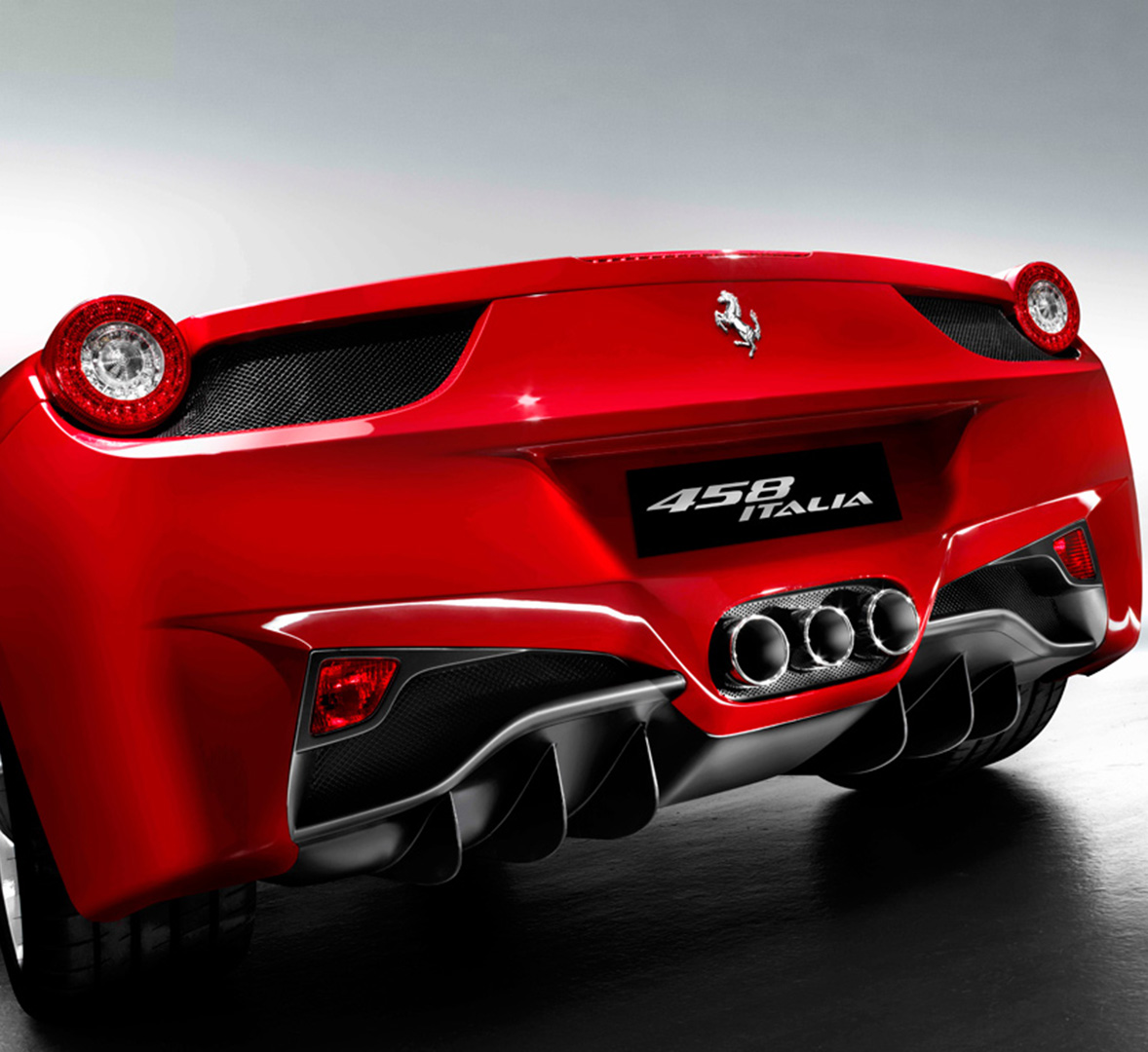
The use of GDI with Split Injection improves engine performance by modulating the injection in two phases, increasing combustion efficiency and the torque at low revs (by up to 5 per cent). A high injection pressure (200 bar) guarantees adequate pulverisation of the petrol and an optimal air/fuel mix right up to 9000 rpm. This feature again results in better performance and lower fuel consumption. The exhaust system was designed to provide the kind of thrilling soundtrack owners of Ferrari’s V8s are used to whilst also guaranteeing high levels of acoustic comfort. One of the main objectives with the exhaust was to reduce weight. The catalytic converter is attached to the central section of the exhaust by a flexible element to reduce the amount of vibration transmitted and to thus allow thinner metal to be used. Similarly the pre-catalytic converter has been eliminated, lowering overall weight and reducing back pressure whilst still respecting strict Euro 5 and LEV2 emissions.
The technology is based on the independent management of even and odd gears which are pre-selected using two separate input shafts. The gear shifting time (the overlap between the opening and closing phases of the two clutches) is zero and thus there is no interruption of engine torque to the driven wheels. Compared to the California gearbox, response times have been reduced and the 458 Italia has specific, sportier gear ratios to match the power and torque curves of the new V8, guaranteeing high torque even at lower revs. The E-Diff 3 electronic differential has also been integrated into the gearbox, resulting in a more compact and lighter unit.
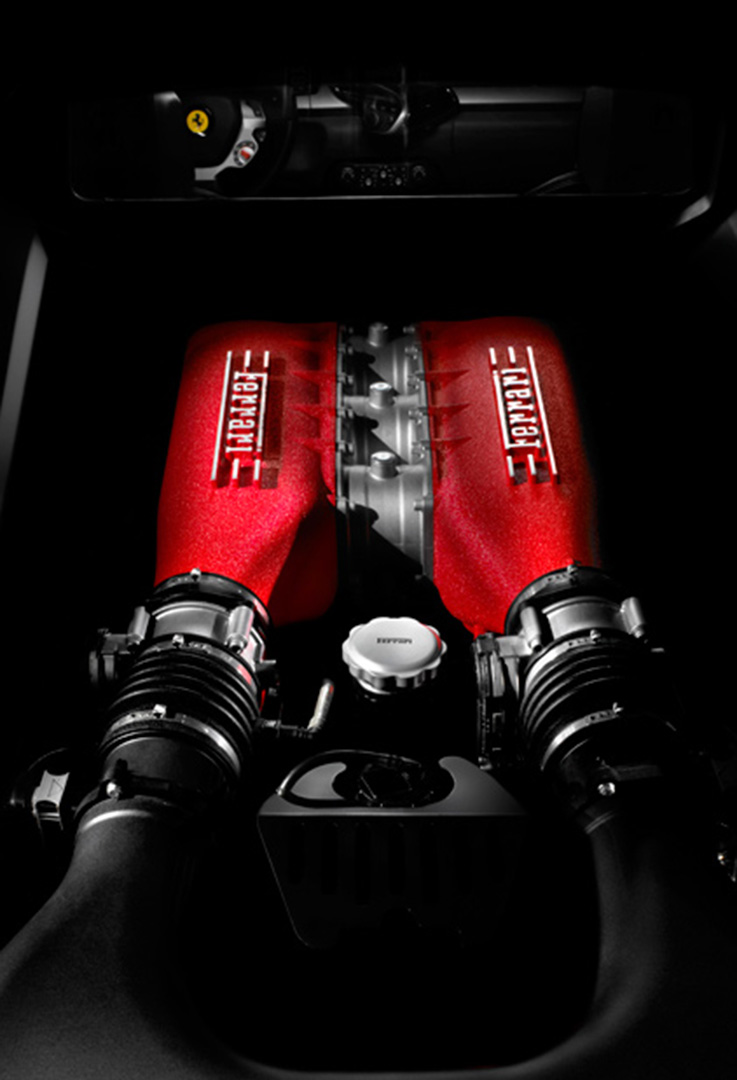

STYLING AND AERODYNAMIC REQUIREMENTS
The nose features a single opening for the front grille and side air intakes, with aerodynamic sections and profiles designed to direct air to the coolant radiators and the new flat underbody. The nose also sports small aeroelastic winglets which generate downforce and, as speed rises, deform to reduce the section of the radiator intake and cut drag. The oil radiators for the F1 gearbox and the dual-clutch are situated in the tail and air is fed from two intakes on the top of the rear wings. This solution provides a base bleed effect, an aerodynamic function that was developed by Ferrari for the FXX and which reduces drag by feeding the hot air out of the radiators under the nolder and into the slip stream.
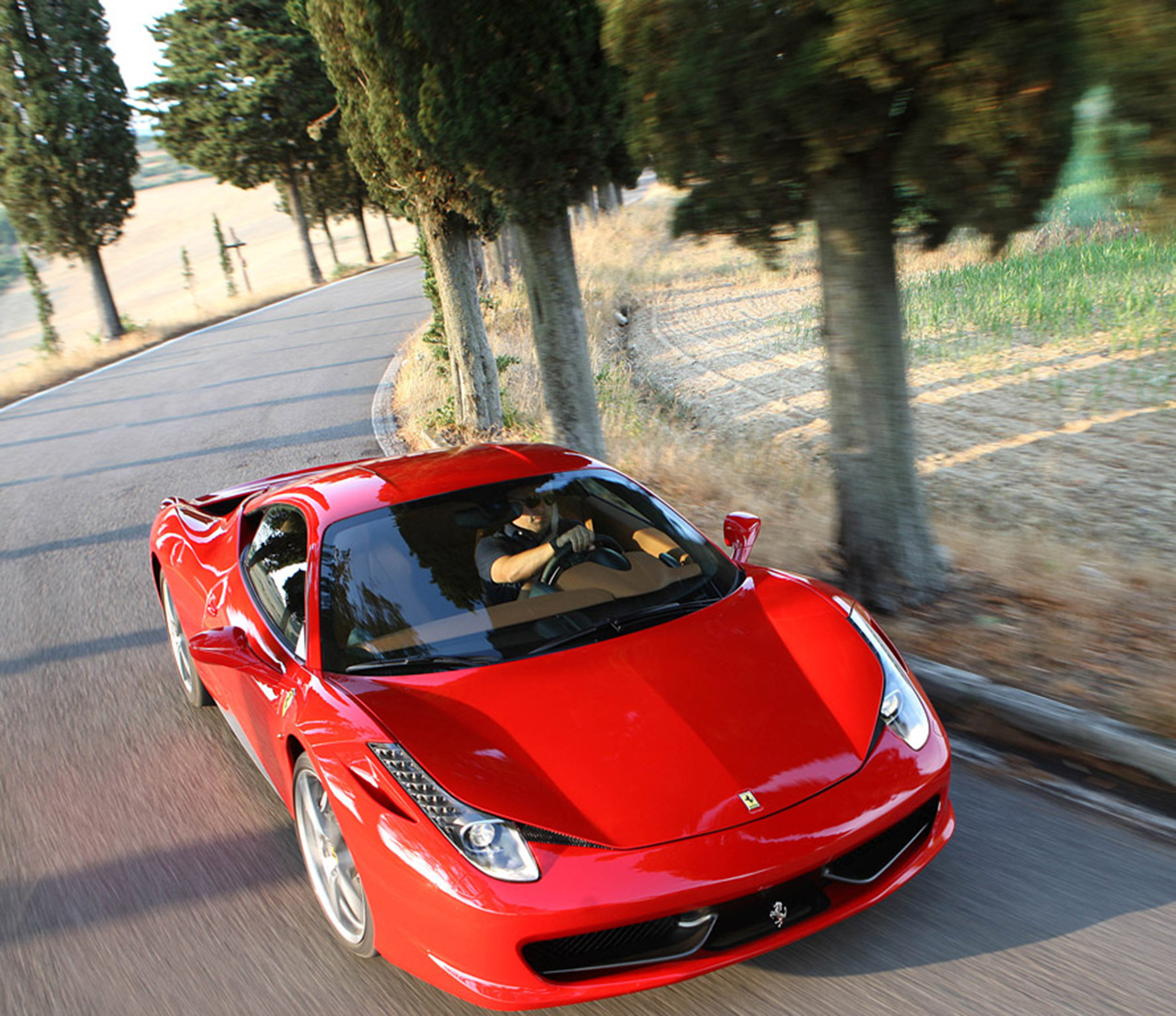
Technical development of the car's shaped started using CFD (Computational Fluid- Dynamic) techniques which helped optimise the management and interaction of the internal flows prior to wind tunnel testing. The latter was carried out on Ferrari's rolling road facility using modular 1:3 scale models. The final solution chosen ensured adequate cooling to the running gear, while, at the same time, achieving a high level of aerodynamic efficiency (1.09) through excellent drag and downforce figures (Cd 0.33 and Cl 0.36 respectively) with 140 kg of downforce at 200 km/h and no less than 360 kg at top speed.
The front-mounted coolant radiators are trapezoidal in shape and positioned to minimise the impact of the internal cooling flows on drag and downforce. The oil radiators for the gearbox and clutch are situated in the tail with air fed from two intakes on the top of the rear wings. The hot air from the radiators creates a base bleed effect, venting into the car's low-pressure trail below the nolder and reducing drag. The air intakes for engine bay cooling are situated on the aerodynamic underbody, where differences in pressure channel the air in the most efficient manner, and are positioned to increase rear downforce. Similarly air is channelled from the front air dam to the rear diffuser where the position and number of the fences has been developed to optimise the distribution of the vortex to improve rear downforce.
Using experience gained in aerodynamic development on the Ferrari F430 GT2, the flat underbody now incorporates the air intakes for engine bay cooling. These are positioned ahead of the rear wheelarches where they use pressure differences to efficiently channel air flow to the engine bay, at the same time generating more rear downforce. The car's sills are characterised by two keel forms that act as fairings to the rear wheels, while the rear bodywork between the rear diffusers acts as the surround to the novel triple exhaust tail pipes, a styling cue that recalls the legendary F40 and gives the 458 Italia's tail an aggressive sporty stance. The engine, in mid-rear V8 Ferrari tradition, is visible below the engine cover.


outstanding braking distances
The 458 Italia boasts outstanding braking distances (100-0 km/h in 32.5 metres; 200- 0 km/h in 128 metres) thanks to the development and optimisation of the Bosch control logic and the evolution of Ferrari’s Pre-Fill logic, which reduces response times by activating the pistons in the callipers, thus minimising the gap between the brake pad and the disc as soon as the driver lifts off the accelerator. Similarly, these excellent results were achieved thanks to a specific calibration of the ABS for medium/high grip surfaces, and by integrating the ABS control logic with that of the E-Diff 3 to ensure a more accurate estimate of the vehicle speed and hence better braking torque control, as well as enhanced vehicle stability.
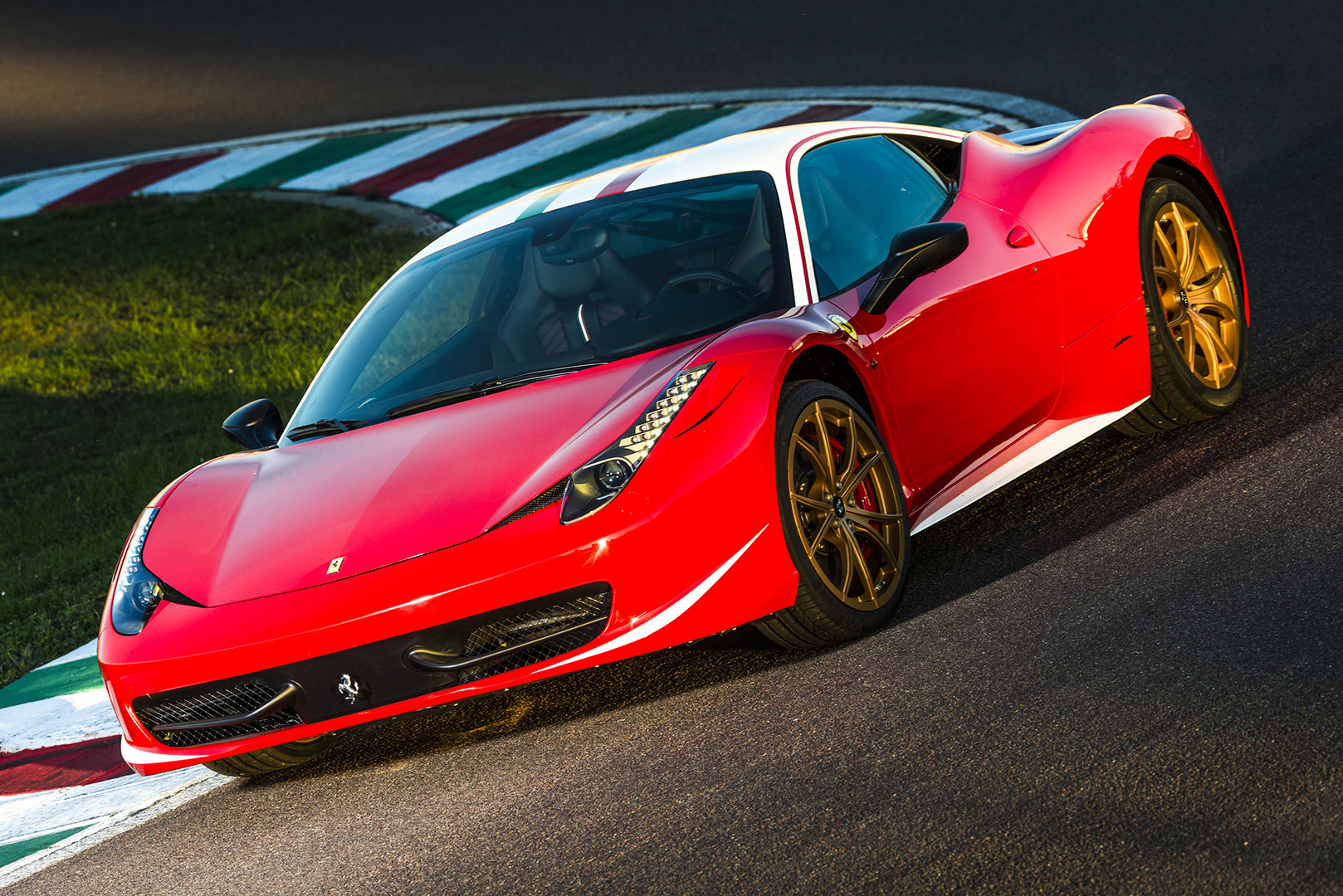
The 458 Italia's front suspension employs a novel new double wishbone set-up which features an L-shape design for the lower wishbone, with the rearward facing arm longer than the one in line with the wheel axis to provide greater longitudinal flexibility. This in turn improves the car's ability to absorb bumps and it also reduces suspension noise.
Another benefit is in terms of greater transverse rigidity which improves handling. The same characteristics are shared by the new rear multi-link suspension and, combined with specific tyre development, overall vertical rigidity has thus been improved (+35 per cent with respect to the F430) for less body roll, and the engineers were able to introduce a more direct steering ratio (11.9° compared to the F430's 16.9°, a reduction of 30 per cent) which makes for quicker and more responsive steering on both road and track.
The 458 Italia also features the latest, second-generation Magnetorheological Suspension Control shock absorber system. Compared to the system first introduced on the 599 GTB Fiorano, SCM2 boasts an evolved ECU (-50 per cent input time) and a damper force generation time of 8 ms compared to the 599's 15 ms.
There is also a new piston rod bushing in the damper which reduces internal friction (-35 per cent) for more precise small-bump control and improved ride comfort.
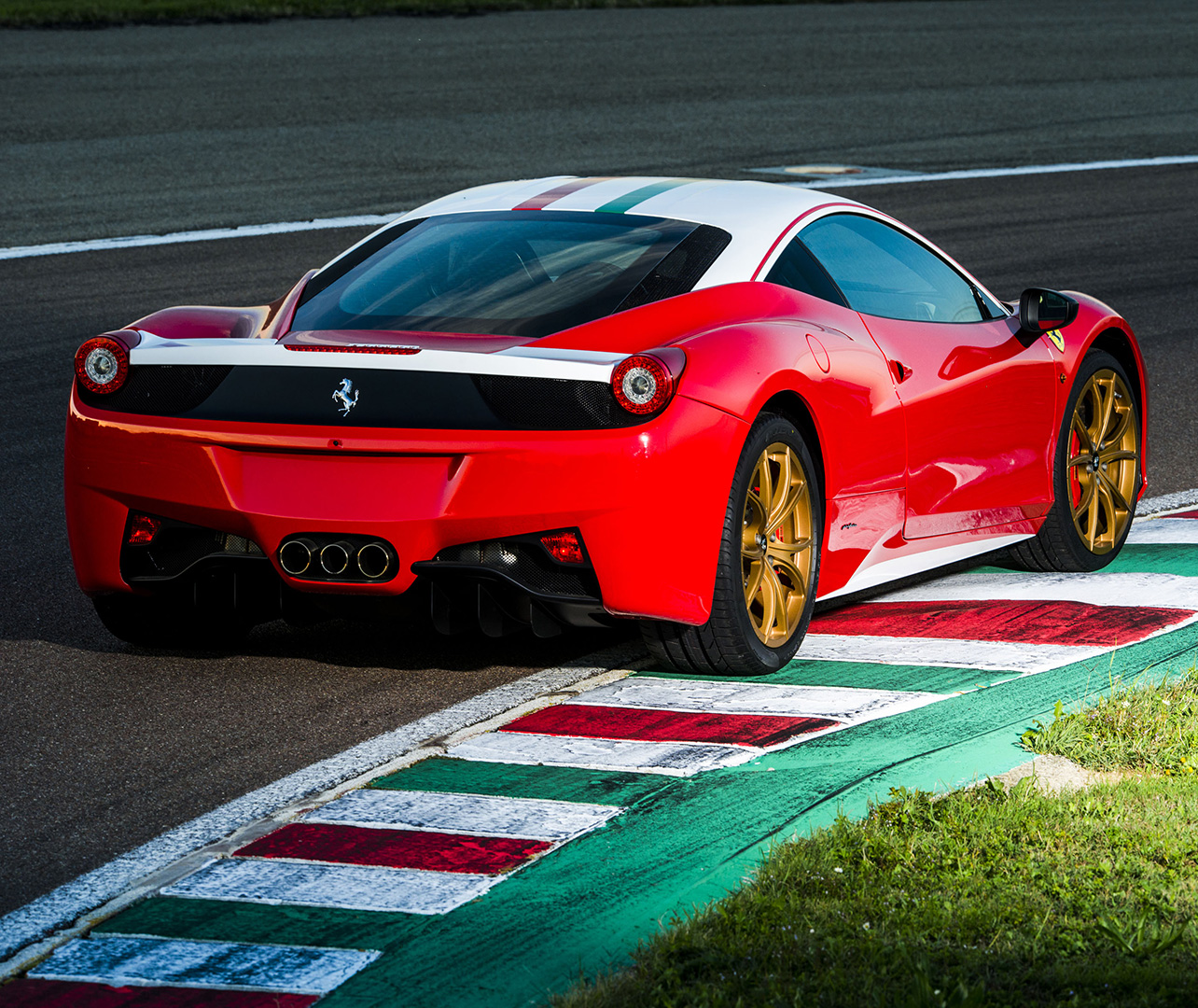

E-DIFF AND F1-TRAC INTEGRATED IN THE SAME ECU
This minimises communication times between the two systems and, at the same time, the individual logics were evolved to improve vehicle performance. A new Power On strategy has been developed for the E-DIff governing traction out of corners and is integrated with the F1-Trac logic, an evolution in the combined action of both systems which is also connected with the high-performance ABS control logic, which is specially set up for high-grip surfaces.The electronic differential continuously distributes torque to the rear wheels, both in Power Off (turning in for the corner) and Power On (accelerating out of the corner), guaranteeing excellent vehicle stability and control in all driving conditions and on all surfaces. The E-Diff 3 now works in a more integrated manner with the F1-Trac, using a series of F1-Trac parameters and evaluations (such as estimates of grip) both in manettino positions in which the F1-Trac is inserted (Sport – Race) and those in which it is deactivated (ESC Off and CST Off).
Compared to previous versions, E-Diff 3 delivers improved torque distribution coming out of corners (in Sport, Race, ESC Off and CST Off), which translates into improved grip, better roadholding and more progressive handling on the limit. The result is an improvement of 32 percent in longitudinal acceleration out of corners compared to previous models and a lap time at Fiorano of just 1" 25 seconds.


COMPACT AND AERODYNAMIC SHAPE
The 458 Italia’s volumes have been honed to a compact and aerodynamic shape by Pininfarina and the Ferrari Centro Stile with the themes of purity, simplicity, technology, efficiency and lightness underpinning the concept.
It is unmistakably a Ferrari, incorporating the characteristics that have become a signature of every car that leaves Maranello. Yet it is also clearly a significant leap forwards from the sporty mid-rear V8 cars that preceded it. This was achieved by aiming for superb driveability in extreme conditions and ensuring that every last component was honed with performance and driving pleasure in mind. Aerodynamic development in the wind tunnel aimed at sculpting the flanks and the tops of the rear wheelarches to naturally channel the air flow to the intakes above the tail. The gearbox and clutch oil radiators have been moved from the sill area to the rear of the engine compartment.
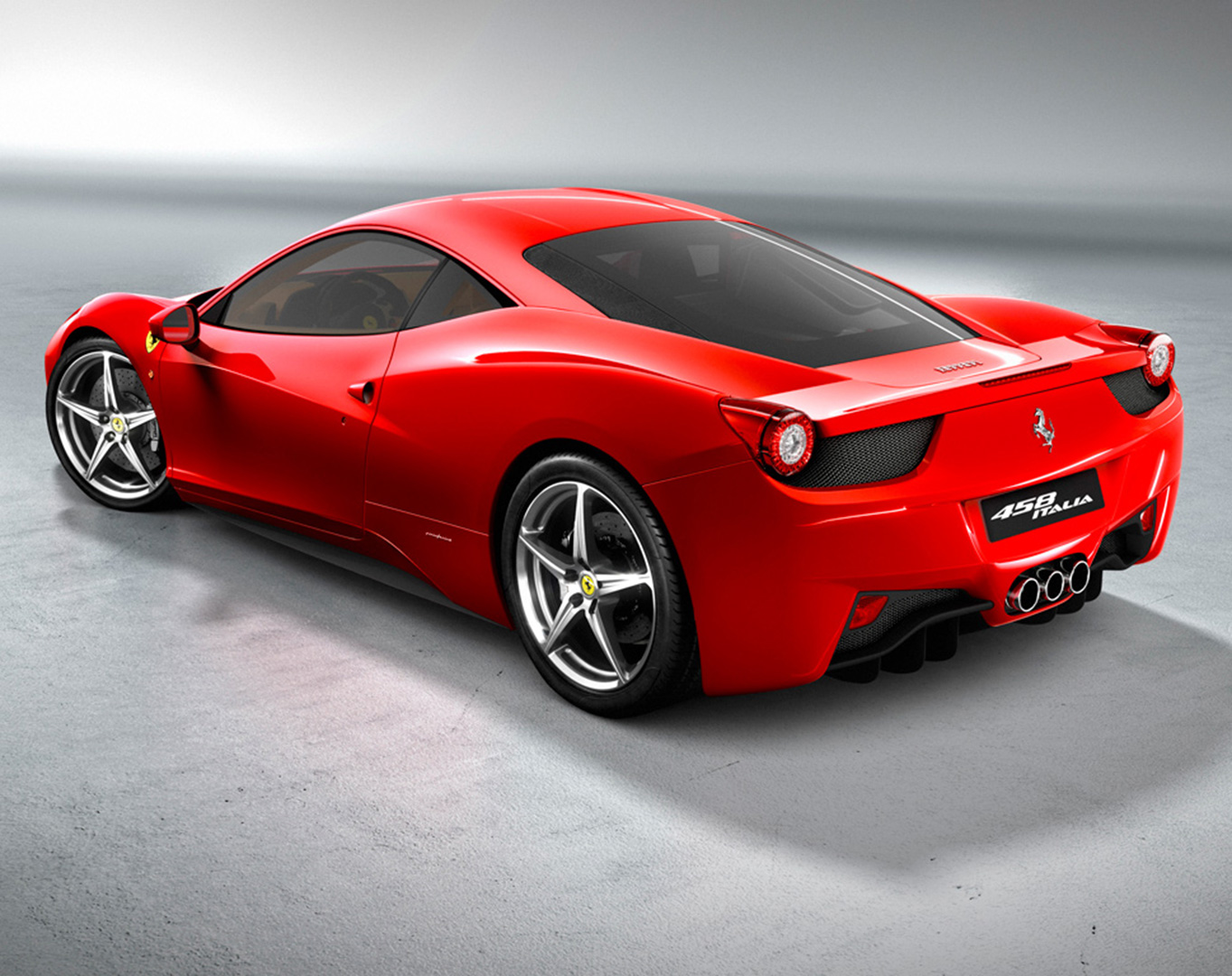
The car’s powerful character is underlined by the swage line along its flanks, rising from the rear of the front wheelarch before dropping half-way along the door to the rear wheelarch. The result is sleeker surfaces higher up and a characteristic scoop over the rear wheelarches. The nose features a single opening for the grille and two large air intakes to channel air to the engine radiators.
The central area has sections and profiles designed to direct the air to the radiators and the flat underbody, with the air to the latter being channelled through the middle of the bumper beneath the central dam. The nose also sports two small aeroelastic winglets which deform at high speeds. Their main function is to generate downforce but they also improve cooling by channelling air to the radiators.
The headlights are designed to give the 458 Italia a characteristic stance. The main lens is a rotating bi-xenon light with low- and fullbeam functions, which follows the car’s movements in line with the curves on the road. Above it is a vertical stack of 20 high-intensity LEDs for the DRLs or daylight running lights (their intensity increases with the intensity of daylight) and indicators. The characteristic brake air intake is a natural, harmonious part of the intersection of the headlight, wheel arch and bonnet volumes. On top of the wing outside the headlights is a vent for radiator cooling.

Below the characteristic rear nolder are two large air vents from the gearbox and clutch radiators with the prominent circular tail-light assemblies mounted on the edge of the wheelarches.
The car’s sills are characterised by two keel forms that act as fairings to the rear wheels, while the rear bodywork between the rear diffusers acts as the surround to the novel triple exhaust tail pipes, a styling cue that recalls the legendary F40 and clearly hints at the 458 Italia’s sporty character. As is traditional for Ferrari’s 8-cylinder sports cars, the engine can be seen through the rear screen.
The exterior architecture focused on keeping weight down, reducing the frontal section to reduce drag, and on lowering the car’s centre of gravity. The result of this mix is enhanced handling and roadholding as well as a correct ratio between the wheelbase, overhangs and front and rear track.
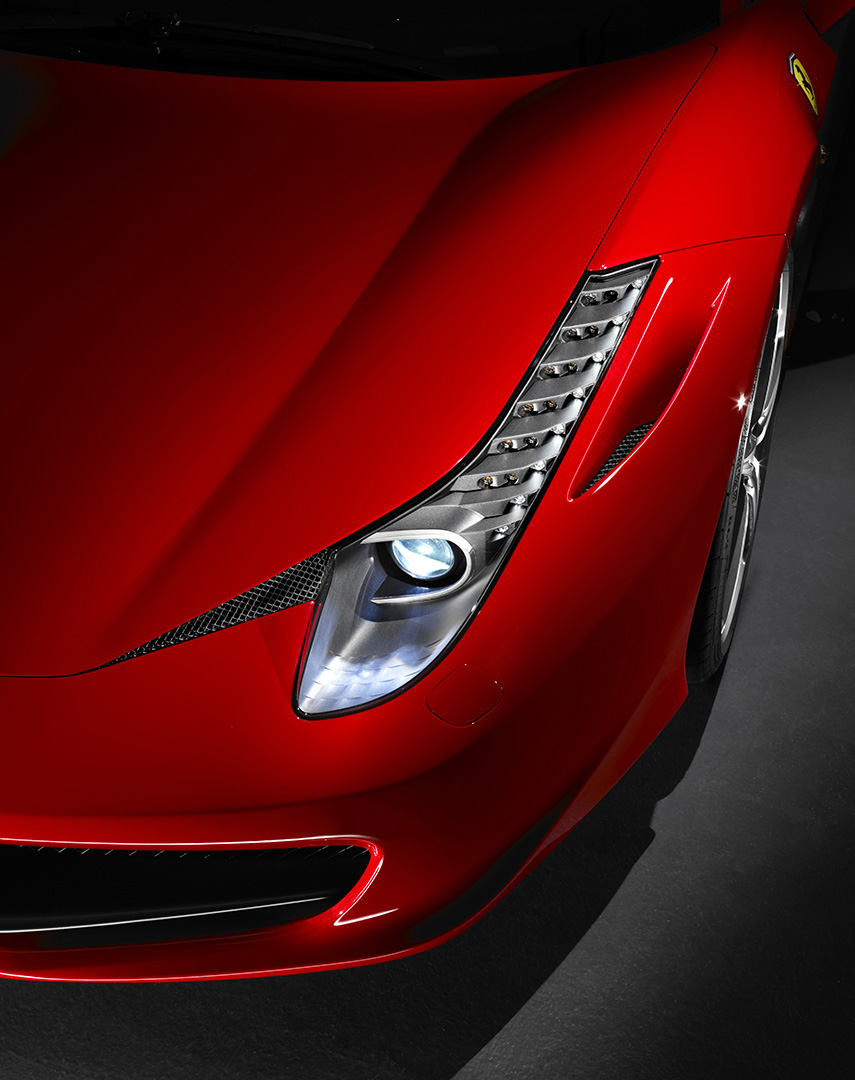
Architecture
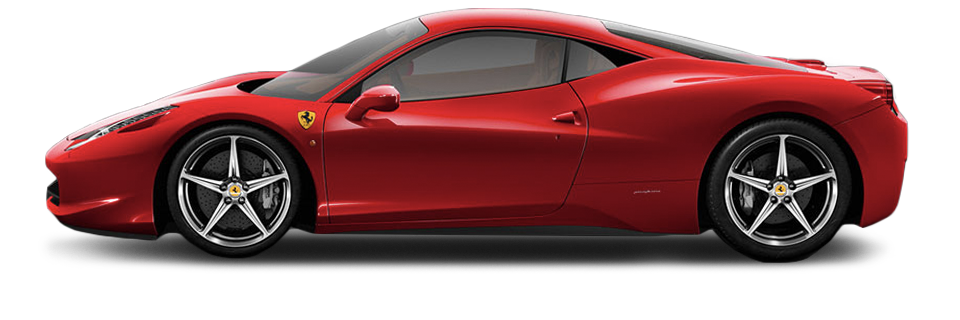


FUNCTIONAL AND ERGONOMIC DESIGN
The stylistic choices in the interior developed by Ferrari Centro Stile reflect the functional, ergonomic design of the cockpit. The driver is set in the centre of a streamlined, intuitive layout, very much in line with the marque’s signature styling cues.
The instrument panel consists of two leather-trimmed shells which outline the clean, overlapping forms from which the central aluminium structure emerges that house the instruments.
The styling of the steering wheel underscores a sense of continuity with classic Ferrari styling cues (such as the aluminium central pad), whilst representing at the same time innovation by eliminating the indicator and windscreen wiper stalks and clustering all of the controls on the steering wheel.
The centre console features a sculptural aluminium casting which houses the F1 gearshift panel and its dynamic controls: the Launch Control button, reverse, and the Auto switch to put the gearbox in automatic mode.

- V8ENGINE
- 4497 ccTOTAL DISPLACEMENT
- 570 CVMAXIMUM POWER @ 9000
- >325 km/hTOP SPEED
- TypeV8 – 90°
- Total displacement274.4 cu in (4497 cc)
- Maximum power419 kW (570 CV)** @ 9000 rpm
- Maximum torque398 lbs/ft (540 Nm) @ 6000 rpm
- Specific power output127CV/l
- Compression ratio12.5:1
- Front235/35 ZR20 8.5”
- Rear295/35 ZR20 10.5”
- Overall length178.2 in (4527 mm)
- Overall width76.3 in (1937 mm)
- Height47.8 in (1213 mm)
- Wheelbase104.3 in (2650 mm)
- Dry weight3042 lbs (1380 kg)*
- Weight/power ratio7.16 lbs/kW (2,42 kg/CV)
- Weight distribution fr/r42%/58%
- Maximum speed>202 mph (>325 km/h)
- 0-100 km/h<3.4s
- Fuel consumption***13.3/100km
- Emissions***307 g CO2/km
- GearboxDual-clutch, 7-speed F1
- ElectronicsE-Diff3, F1-Trac, high-performance ABS
- *With forged wheels and Racing seats
- **Including 5 CV of ram effect
- ***Combined cycle (ECE+EUDC)
- engine
- aerodynamics
- dynamics
- Vehicle controls
- design
- Interior
- Technical Details
- Media gallery
